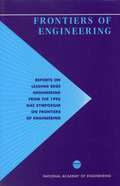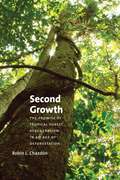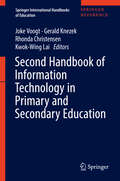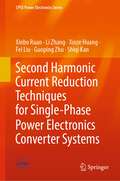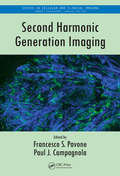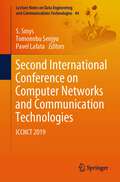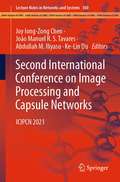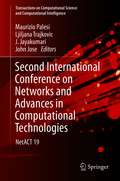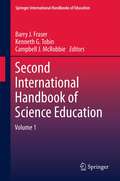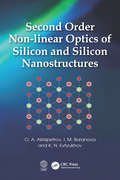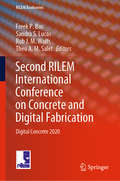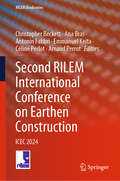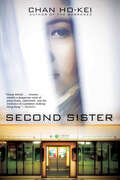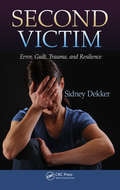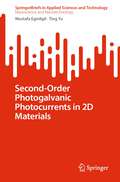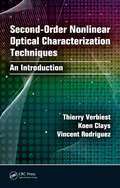- Table View
- List View
Sebastopol's Gravenstein Apple Industry
by Western Sonoma County Historical SocietyThe Gravenstein apple has been etched into the identity of Sebastopol, California, which is one of the few places on earth to have extensively grown this elusive apple. The Gravenstein is an early apple whose only failing is perishability, but it is celebrated for its superior flavor. Yet Luther Burbank attempted to improve on the Gravenstein, producing the Winterstein and the Bonita for home gardeners. During the last 127 years, the Gravenstein has added millions of dollars to the local economy. It has provided a reason for celebrations, from the 1910 Apple Show to today's Apple Blossom Festival and Gravenstein Apple Fair. This is the Gravenstein's story, from its European roots to small-town homage, and the part this special apple has played in one community--and the reason the current decline in apple acreage is mourned.
Second Annual Symposium on Frontiers of Engineering
by National Academy of Engineering Staff Second Annual Symposium on Frontiers of Engineering StaffSpace may have been called the "final frontier," but there are new frontiers to discover every day and engineers are the ones exploring them. Through groundbreaking research and cutting-edge technologies, engineers are now able to go beyond traditional boundaries, doing things that would have been all but impossible just a few short years ago. A sample of these exciting frontiers is revealed in this new publication from the National Academy of Engineering, which looks at new and emerging technologies to explain how they were developed and what new benefits they will bring. The book also highlights the kinds of pioneering research and technological work being done by some of the country's emerging leaders in engineering. Topics covered include microelectromechanical systems, design research, computer-generated visualization for design and display, and innovations in materials and processes.
Second Generation Biometrics: The Ethical, Legal and Social Context
by Dimitros Tzovaras Emilio MordiniWhile a sharp debate is emerging about whether conventional biometric technology offers society any significant advantages over other forms of identification, and whether it constitutes a threat to privacy, technology is rapidly progressing. Politicians and the public are still discussing fingerprinting and iris scan, while scientists and engineers are already testing futuristic solutions. Second generation biometrics - which include multimodal biometrics, behavioural biometrics, dynamic face recognition, EEG and ECG biometrics, remote iris recognition, and other, still more astonishing, applications - is a reality which promises to overturn any current ethical standard about human identification. Robots which recognise their masters, CCTV which detects intentions, voice responders which analyse emotions: these are only a few applications in progress to be developed. This book is the first ever published on ethical, social and privacy implications of second generation biometrics. Authors include both distinguished scientists in the biometric field and prominent ethical, privacy and social scholars. This makes this book an invaluable tool for policy makers, technologists, social scientists, privacy authorities involved in biometric policy setting. Moreover it is a precious instrument to update scholars from different disciplines who are interested in biometrics and its wider social, ethical and political implications.
Second Growth: The Promise of Tropical Forest Regeneration in an Age of Deforestation
by Robin L. ChazdonFor decades, conservation and research initiatives in tropical forests have focused almost exclusively on old-growth forests because scientists believed that these "pristine” ecosystems housed superior levels of biodiversity. With Second Growth, Robin L. Chazdon reveals those assumptions to be largely false, bringing to the fore the previously overlooked counterpart to old-growth forest: second growth. Even as human activities result in extensive fragmentation and deforestation, tropical forests demonstrate a great capacity for natural and human-aided regeneration. Although these damaged landscapes can take centuries to regain the characteristics of old growth, Chazdon shows here that regenerating--or second-growth--forests are vital, dynamic reservoirs of biodiversity and environmental services. What is more, they always have been. With chapters on the roles these forests play in carbon and nutrient cycling, sustaining biodiversity, providing timber and non-timber products, and integrated agriculture, Second Growth not only offers a thorough and wide-ranging overview of successional and restoration pathways, but also underscores the need to conserve, and further study, regenerating tropical forests in an attempt to inspire a new age of local and global stewardship.
Second Handbook of Information Technology in Primary and Secondary Education
by Joke Voogt Gerald Knezek Rhonda Christensen Kwok-Wing LaiIn this second edition the editors continue their efforts to synthesize research and practice and project future directions in the field of information and communication technology. The proliferation of mobile devices and applications have had major implications on how the nature of teaching and learning should be conceptualised, and what pedagogical practices should be used to support bridging formal and informal learning. The advent of social media also highlights the importance of gaining a deeper understanding of social learning theories and computer-supported collaborative learning theories and practices. The advancement of new technologies to support easy accessibility of educational resources such as OER and to a lesser extent MOOCs have led to the debate on how assessment should be conducted and how technologies could be used to support it. The demand of the knowledge society requires that researchers, policy makers, and educational practitioners be conversant with new research findings in order to understand the impact of ICT in teaching and learning, and how to support learners to use new technologies and applications creatively and effectively. New research paradigms have emerged to meet these challenges.
Second Harmonic Current Reduction Techniques for Single-Phase Power Electronics Converter Systems (CPSS Power Electronics Series)
by Li Zhang Fei Liu Xinbo Ruan Xinze Huang Guoping Zhu Shiqi KanTwo-stage single-phase converters, including two-stage single-phase dc-ac inverters and two-stage single-phase PFC converters, are interfacing power converters between dc and ac voltage/current sources, which have been widely applied for dc-ac and ac-dc power conversion. For the two-stage single-phase converter, the ac-side power pulsates at twice the ac voltage frequency, resulting in second harmonic current (SHC) which might flow into the dc-dc converter, the dc voltage source, and dc load. This book clarifies the generation, propagation, and side-effects of this SHC and proposes the SHC reduction control schemes for the dc-dc converter, with different topologies and/or different operating modes, in the single-phase converter. On this basis, the second harmonic current compensator (SHCC) is proposed to compensate the SHC, significantly reducing the dc bus capacitance. In doing so, the electrolytic capacitors, with short lifetimes, are removed from the two-stage single-phase converter, leading to extended system lifetime and enhanced system stability. For having flawless SHC compensation performance, the port-current control schemes are proposed for the SHCC. Additionally, the stability analysis is carried out for the two-stage single-phase converter with the addition of SHCC. This book is a monograph combining theoretical analysis and engineering design, which could not only be a reference book for master students, Ph.D. students, and teachers majoring in power electronics but also be a handbook for the electrical engineers working on the research and development of LED drivers, EV on-board chargers, railway auxiliary power supplies, aviation power supplies, renewable energy generation systems, etc.
Second Harmonic Generation Imaging
by Francesco S. Pavone Paul J. CampagnolaSecond-harmonic generation (SHG) microscopy has shown great promise for imaging live cells and tissues, with applications in basic science, medical research, and tissue engineering. Second Harmonic Generation Imaging offers a complete guide to this optical modality, from basic principles, instrumentation, methods, and image analysis to biomedical a
Second International Conference on Computer Networks and Communication Technologies: ICCNCT 2019 (Lecture Notes on Data Engineering and Communications Technologies #44)
by S. Smys Pavel Lafata Tomonobu SenjyuThis book presents new communication and networking technologies, an area that has gained significant research attention from both academia and industry in recent years. It also discusses the development of more intelligent and efficient communication technologies, which are an essential part of current day-to-day life, and reports on recent innovations in technologies, architectures, and standards relating to these technologies. The book includes research that spans a wide range of communication and networking technologies, including wireless sensor networks, big data, Internet of Things, optical and telecommunication networks, artificial intelligence, cryptography, next-generation networks, cloud computing, and natural language processing. Moreover, it focuses on novel solutions in the context of communication and networking challenges, such as optimization algorithms, network interoperability, scalable network clustering, multicasting and fault-tolerant techniques, network authentication mechanisms, and predictive analytics.
Second International Conference on Image Processing and Capsule Networks: ICIPCN 2021 (Lecture Notes in Networks and Systems #300)
by Ke-Lin Du João Manuel R. S. Tavares Joy Iong-Zong Chen Abdullah M. IliyasuThis book includes the papers presented in 2nd International Conference on Image Processing and Capsule Networks [ICIPCN 2021]. In this digital era, image processing plays a significant role in wide range of real-time applications like sensing, automation, health care, industries etc. Today, with many technological advances, many state-of-the-art techniques are integrated with image processing domain to enhance its adaptiveness, reliability, accuracy and efficiency. With the advent of intelligent technologies like machine learning especially deep learning, the imaging system can make decisions more and more accurately. Moreover, the application of deep learning will also help to identify the hidden information in volumetric images. Nevertheless, capsule network, a type of deep neural network, is revolutionizing the image processing domain; it is still in a research and development phase. In this perspective, this book includes the state-of-the-art research works that integrate intelligent techniques with image processing models, and also, it reports the recent advancements in image processing techniques. Also, this book includes the novel tools and techniques for deploying real-time image processing applications.The chapters will briefly discuss about the intelligent image processing technologies, which leverage an authoritative and detailed representation by delivering an enhanced image and video recognition and adaptive processing mechanisms, which may clearly define the image and the family of image processing techniques and applications that are closely related to the humanistic way of thinking.
Second International Conference on Networks and Advances in Computational Technologies: NetACT 19 (Transactions on Computational Science and Computational Intelligence)
by Maurizio Palesi Ljiljana Trajkovic J. Jayakumari John JoseThis book presents the proceedings of the 2nd International Conference on Networks and Advances in Computational Technologies (NetACT19) which took place on July 23-25, 2019 at Mar Baselios College of Engineering and Technology in Thiruvananthapuram, India. The conference was in association with Bowie State University, USA, Gannon University, USA and Malardalen University, Sweden. Papers presented were included in technical programs that were part of five parallel tracks, namely Computer Application, Image Processing, Network Security, Hardware & Network Systems and Machine Learning. The proceedings brings together experts from industry, governments and academia from around the world with vast experiences in design, engineering and research.Presents the proceedings of the 2nd International Conference on Networks and Advances in Computational Technologies (NetACT19);Includes research in Computer Application, Image Processing, Network Security, Hardware & Network Systems and Machine Learning;Provides perspectives from industry, academia and government.
Second International Conference on Sustainable Technologies for Computational Intelligence: Proceedings of ICTSCI 2021 (Advances in Intelligent Systems and Computing #1235)
by Xiao-Zhi Gao Ashish Kumar Luhach Dharm Singh Jat Ramesh Chandra PooniaThis book gathers high-quality papers presented at the Second International Conference on Sustainable Technologies for Computational Intelligence (ICTSCI 2021) held at Graphic Era University, Dehradun, India, during May 22–23, 2021. It covers emerging topics in computational intelligence and effective strategies for its implementation in engineering applications.
Second International Handbook of Science Education
by Campbell J. Mcrobbie Barry J. Fraser Kenneth TobinThe International Handbook of Science Education is a two volume edition pertaining to the most significant issues in science education. It is a follow-up to the first Handbook, published in 1998, which is seen as the most authoritative resource ever produced in science education. The chapters in this edition are reviews of research in science education and retain the strong international flavor of the project. It covers the diverse theories and methods that have been a foundation for science education and continue to characterize this field. Each section contains a lead chapter that provides an overview and synthesis of the field and related chapters that provide a narrower focus on research and current thinking on the key issues in that field. Leading researchers from around the world have participated as authors and consultants to produce a resource that is comprehensive, detailed and up to date. The chapters provide the most recent and advanced thinking in science education making the Handbook again the most authoritative resource in science education.
Second Order Non-linear Optics of Silicon and Silicon Nanostructures
by O. A. Aktsipetrov I. M. Baranova K. N. EvtyukhovThe theory and practice of the non-linear optics of silicon are inextricably linked with a variety of areas of solid state physics, particularly semiconductor physics. However, the current literature linking these fields is scattered across various sources and is lacking in depth. Second Order Non-linear Optics of Silicon and Silicon Nanostructures describes the physical properties of silicon as they apply to non-linear optics while also covering details of the physics of semiconductors. The book contains six chapters that focus on: The physical properties and linear optics of silicon Basic theoretical concepts of reflected second harmonics (RSH) The authors’ theory of the generation of RSH at the non-linear medium–linear medium interface An analytical review of work on the non-linear optics of silicon The results of non-linear optical studies of silicon nanostructures A theory of photoinduced electronic processes in semiconductors and their influence on RSH generation The book also includes methodological problems and a significant amount of reference data. It not only reflects the current state of research but also provides a single, thorough source of introductory information for those who are becoming familiar with non-linear optics. Second Order Non-linear Optics of Silicon and Silicon Nanostructures is a valuable contribution to the fields of non-linear optics, semiconductor physics, and microelectronics, as well as a useful resource for a wide range of readers, from undergraduates to researchers.
Second RILEM International Conference on Concrete and Digital Fabrication: Digital Concrete 2020 (RILEM Bookseries #28)
by Freek P. Bos Sandra S. Lucas Rob J. M. Wolfs Theo A. M. SaletThis book gathers peer-reviewed contributions presented at the 2nd RILEM International Conference on Concrete and Digital Fabrication (Digital Concrete), held online and hosted by the Eindhoven University of Technology, the Netherlands from 6-9 July 2020. Focusing on additive and automated manufacturing technologies for the fabrication of cementitious construction materials, such as 3D concrete printing, powder bed printing, and shotcrete 3D printing, the papers highlight the latest findings in this fast-growing field, addressing topics like mixture design, admixtures, rheology and fresh-state behavior, alternative materials, microstructure, cold joints & interfaces, mechanical performance, reinforcement, structural engineering, durability and sustainability, automation and industrialization.
Second RILEM International Conference on Earthen Construction: ICEC 2024 (RILEM Bookseries #52)
by Arnaud Perrot Christopher Beckett Antonin Fabbri Ana Bras Emmanuel Keita Céline PerlotThis book gathers the peer-reviewed papers presented at the Second RILEM International Conference on Earthen Construction (ICEC), held in Edinburgh, United Kingdom, on July 8–10, 2024. It highlights the latest advances and innovations in the field of con earth-based building materials and construction. The conference topics encompass material characterisation and quality control, hydro-mechanical behaviour, reinforcement behaviour, seismic behaviour, in situ and field testing, additive manufacturing (3D printing), rheology, biostabilisation, molecular simulation, microstructure, durability, fire performance, hygro-thermal behaviour, life cycle analysis, climate change adaptation, economic impacts, and earthen architecture. As such, the book represents an invaluable, up-to-the-minute tool, and offers an important platform to engineers, architects, and geophysicists.
Second Sister
by Chan Ho-KeiA reclusive Hong Kong PI and hacker investigates a teenager’s mysterious death in this technological thriller by the author of The Borrowed.A schoolgirl—Siu-Man—has committed suicide, leaping from her twenty-second floor window to the pavement below. Siu-Man is an orphan and the librarian older sister who’s been raising her refuses to believe there was no foul play—nothing seemed amiss. She contacts a man known only as N.—a hacker, and an expert in cybersecurity and manipulating human behavior. But can Nga-Yee interest him sufficiently to take her case, and can she afford it if he says yes?What follows is a cat and mouse game through the city of Hong Kong and its digital underground, especially an online gossip platform, where someone has been slandering Siu-Man. The novel is also populated by a man harassing girls on mass transit; high school kids, with their competing agendas and social dramas; a Hong Kong digital company courting an American venture capitalist; and the Triads, market women and noodle shop proprietors who frequent N.’s neighborhood of Sai Wan. In the end it all comes together to tell us who caused Siu-Man’s death and why, and to ask, in a world where online and offline dialogue has increasingly forgotten about the real people on the other end, what the proper punishment is.“Readers will savor every twist and turn of Chan Ho-Kei’s tour de force. . . . Second Sister is a masterclass on the vagaries of our digital age.” —Criminal Element“[A] clever, twisty novel. . . . Fans of hacker thrillers such as Stieg Larsson’s Lisbeth Salander books will be amply rewarded.” —Publishers Weekly, starred review, PW Pick“Virtually irresistible, with twisty-turny, didn't-see-that-coming manipulations guaranteed to keep readers wide awake into the wee hours. . . . For readers, the provocative mix of urgent contemporary issues and page-turning action won't disappoint.” —Shelf Awareness
Second Victim: Error, Guilt, Trauma, and Resilience
by Sidney DekkerHow do people cope with having "caused" a terrible accident? How do they cope when they survive and have to live with the consequences ever after? We tend to blame and forget professionals who cause incidents and accidents, but they are victims too. They are second victims whose experiences of an incident or adverse event can be as traumatic as tha
Second-Order Photogalvanic Photocurrents in 2D Materials (SpringerBriefs in Applied Sciences and Technology)
by Ting Yu Mustafa EginligilThis book highlights the photogalvanic effects at low dimensions, surfaces, and interfaces, more specifically 2D materials, such as graphene and monolayer transition metal dichalcogenides. Although the phenomenology of the photogalvanic effects, which can be simply seen as photoresponse nonlinear-in-electric field, have been well-established, the microscopic understanding in each material system may vary. This book is a quick reference and a detailed roadmap starting from phenomenology and continuing with the ultimate low dimensional materials, in which the photogalvanic effects can offer a rich platform at the second-order response to an electric field. A general phenomenology of photogalvanic effect is provided in the first chapter, together with the photon drag effect which also generates a photocurrent like the photogalvanic effect, but with some distinct features, as well as somewhat puzzling similarities. Next two chapters explain these effects in graphene, starting with a necessary related background on graphene, then a particular focus on its specific phenomenology, microscopic theory, and experimental results. In a similar fashion, in chapters four and five, a necessary background for the photogalvanic effects in monolayer transition metal dichalcogenides, with symmetry analysis, microscopic theory, and experimental results is presented, along with the Berry curvature dependent photocurrent, which can also play an important role in 2D semiconductors. The second-order photogalvanic effects that have been covered so far in graphene and monolayer transition metal chalcogenides have already excited the 2D semiconductor optoelectronic research community by several means. It seems that the interests on the photogalvanic effects will continue to escalate in near future.
Second-order Nonlinear Optical Characterization Techniques: An Introduction
by Thierry Verbiest Koen Clays Vincent RodriguezAlthough chemists, biochemists, biologists, and material scientists are often interested in using nonlinear optical techniques for characterizing their samples, they seldom have the necessary background to exploit these methods. Designed for nonspecialists, Second-Order Nonlinear Optical Characterization Techniques: An Introduction focuses on the p
Secondary Agriculture: Sustainability and Livelihood in India
by Syed Sheraz Mahdi F. A. Bahar M. Anwar BhatThis book on ‘Secondary Agriculture’ discusses the goal of doubling farmers’ incomes. The term ‘secondary’ has a bearing on climate change adaptation and its mitigation, small farm viability and profitability, food security, nutrition, sustainable utilization of natural resources, and optimal usage of produce from primary agriculture and farm incomes. Promoting secondary agriculture has implications on attaining sustainable development goals, which aim to connect primary, secondary and tertiary sectors by using slack/idle factors of production, such as land and labour, contributing to primary agriculture production, capturing ‘value’ in primary agricultural activities, and generating additional income at the enterprise level. In context to same, the chapters of this book have been designed to promote secondary agriculture through low-cost skills and technology applications in agriculture and by upscaling knowledge via integrating primary, secondary and tertiary sectors of agriculture. The motivation behind this book is to address the challenges of biotic and abiotic stresses facing the farming community; to increase farmers income through low-cost skills and technology applications in agriculture; to upscale knowledge by integrating primary, secondary and tertiary sectors of agriculture. The food processing sector in India is still in a nascent stage with only 8 per cent of the produce being processed as against 80-98 per cent in case of high-income countries (Government of India, 2008, 2010). The food processing sector is now receiving the boost with the annual growth of 13.2 per cent in registered food processing units during 2004-10 (Government of India, 2011). Against this backdrop, there is a strong need to strategically handle the situation in order to facilitate a self-sustainable and long-run growth of the sector, which is felt possible by focusing on Secondary Agriculture. Though not a panacea for all ailments of the primary sector, but it can definitely drive the growth.
Secondary Agriculture: Upgrading Agriculture for Jobs and Income
by Ashok Dalwai Ritambhara SinghA first of its kind, this authored book marshals data and logic that necessitate the agriculture sector to transcend beyond its conventional role of securing food, fodder, and feed. It examines India's growing working population and juxtaposes it with the declining labour demand in the secondary and tertiary sectors of the economy, on account of the deployment of disruptive suite of labour-substituting technologies. Therefore, the conventional developmental models that hypothesize the shifting of surplus manpower from agriculture to non-agricultural sectors may not stand the test of scrutiny in the twenty-first century. Hence, the need for remandating the agricultural sector to generate gainful jobs and supplementary incomes in an ecologically synchronous manner for sustainability. The book draws the readers' attention to the importance of bioeconomy and circular economy. To enhance the biologically dependent cumulative agri-output, it recommends the adoption of supplementary and complementary activities. These interventions, along with processing (food and non-food), aid in minimizing food loss, enhancing value capture in favour of the farmers and other value chain stakeholders, and creating gainful jobs and linked incomes resulting in higher enterprise-profits. This progresses the agricultural sector into a bioeconomy anchored around secondary agriculture. Agri-processing being integral to secondary agriculture can be practiced at various scales beginning from micro to small to medium to large. The book highlights both the scope for such enterprises in India and the challenges they are vulnerable to. In the context of sub-par levels of jobs and income in the farm sector, the book emphasizes on micro-enterprises, and suggests the clusterization of entrepreneurs and digitalization along the value chain to achieve competitiveness. The book also deliberates on market-led production matrix, and value chain-based extension services to meet the feedstock demands of secondary agriculture. This book is of relevance to a range of individuals and organizations concerned with agriculture. They include academics, researchers, professionals, universities, domestic & international organizations, bankers & financial institutions, FPOs, entrepreneurs, policymakers, and students.
Secondary Instabilities of Görtler Vortices in High-Speed Boundary Layers
by Jie RenThis thesis first reveals the mechanism of Görtler instabilities and then demonstrates how transitions at hypersonic flows can be effectively controlled (either promoted or suppressed) with Görtler or Klebanoff modes. It focuses on understanding and controlling flow transitions from mild laminar to fully turbulent flows at high speeds—aspects that have become crucial at the dawn of an incredible era, in which hypersonic vehicles are becoming available. Once this occurs, it will be possible to travel from Beijing to Los Angeles within just 2 hours, and we will all live in a genuinely global village—and not just virtually, but physically.Görtler instabilities have often been used to promote flow transition in hypersonic vehicles. However, how Görtler instabilities are excited and how they evolve in hypersonic flows are questions that have yet to be answered.
Secondary Metabolites Based Green Synthesis of Nanomaterials and Their Applications (Smart Nanomaterials Technology)
by Azamal HusenNanotechnology is gaining importance in every field of science and technology. Green synthesis of nanomaterials involves the use of microorganisms such as bacteria, fungi, viruses; and different lower and higher plants. Green synthesis of nanomaterials from plant extracts becoming popular in comparison to synthesis using microorganisms. Plant based-nanomaterials synthesis is easy, have no need to bring back from the culture medium, and is safe. Additionally, plant-based nanomaterials are eco-friendly, in comparison to physical and chemical modes of synthesis. Several lower and higher plants are rich in terms of secondary metabolites. These metabolites have been used as medicine in crude extract form or with some other formulations. They have been also used to isolate the bioactive compounds in modern medicine as well as in herbal medicine systems. Thus, phytochemicals present in the plant and their parts play an important role in nanomaterials synthesis, mainly due to the presence of a significant number of secondary metabolites, for instance, alkaloids, flavonoids, saponins, steroids, tannins, etc. Further, essential and aromatic oils have been also explored for nanomaterials synthesis, and they are also equally useful in terms of their various biological applications. These organic ingredients come from a wide range of plant components, such as leaves, stems, roots, shoots, flowers, bark, and seeds. Globally, the presence of different plants has shown a capability to produce huge and diverse groups of secondary metabolites. The functional groups present in the plant extract acts as capping and stabilizing agent. Most of the time, pure isolated bioactive compounds are more biologically active; hence scholars are focusing their research on the synthesis of nanomaterials using some particular class of secondary metabolites. Investigations have shown that the green synthesized nanomaterials were found to be more biologically active in comparison to chemically synthesized nanomaterials. These nanomaterials and or nanocomposites found different applications especially in drug delivery, detection and cure of cancer cells, diagnosis of a genetic disorder, photoimaging, and angiogenesis detection. They have also shown several applications in agricultural, horticultural as well as forestry sectors. The book in hand covers a wide range of topics as mentioned above. It incorporates chapters that the authors have skilfully crafted with clarity and precision, reviewing up-to-date literature with lucid illustrations. The book would cater to the need of graduate students as a textbook and simultaneously be useful for both novices and experienced scientists and or researchers working in the discipline of nanotechnology, nanomedicine, medicinal plants, plant science, economic botany, chemistry, biotechnology, pharmacognosy, pharmaceuticals, industrial chemistry, and many other interdisciplinary subjects. It should also inspire industrialists and policy makers associated with plant-based nano products.
Secondary Metabolites and Volatiles of PGPR in Plant-Growth Promotion
by R. Z. Sayyed Virgilio Gavicho UarrotaThis contributed volume explores how plant growth-promoting rhizobacterias (PGPR) provide a wide range of benefits to the plant. Further, it discusses the key roles PGPR play in nutrient acquisition and assimilation, improved soil texture, secreting, and modulating extracellular molecules. The book outlines how plant secondary metabolites are natural sources of biologically active compounds used in a wide range of applications, and surveys the significant role of volatile organic compounds (VOCs) in plant communication by mediating above- and below-ground interactions between plants and the surrounding organisms.This volume compiles research from leading scientists from across the globe, linking the translation of basic knowledge to innovative applied research. The book focuses on the following three categories: 1) understanding the secondary metabolites produced by PGPR, the signaling mechanisms and how they affect plant growth, 2) the plausible role of volatile organic compounds produced by PGPR, their role and the signaling mechanism for plant growth promotion, and 3) Applications of VOCs and secondary metabolites of PGPR for seed germination, plant growth promotion; stress tolerance and in-plant health and immunity.
Secondary Metabolites of Medicinal Plants: Ethnopharmacological Properties, Biological Activity and Production Strategies
by Bharat Singh Ram Avtar SharmaCovers the structurally diverse secondary metabolites of medicinal plants, including their ethnopharmacological properties, biological activity, and production strategies Secondary metabolites of plants are a treasure trove of novel compounds with potential pharmaceutical applications. Consequently, the nature of these metabolites as well as strategies for the targeted expression and/or purification is of high interest. Regarding their biological and pharmacological activity and ethnopharmacological properties, this book offers a comprehensive treatment of 100 plant species, including Abutilon, Aloe, Cannabis, Capsicum, Jasminum, Malva, Phyllanthus, Stellaria, Thymus, Vitis, Zingiber, and more. It also discusses the cell culture conditions and various strategies used for enhancing the production of targeted metabolites in plant cell cultures. Secondary Metabolites of Medicinal Plants: Ethnopharmacological Properties, Biological Activity and Production Strategies is presented in four parts. Part I provides a complete introduction to the subject. Part II looks at the ethnomedicinal and pharmacological properties, chemical structures, and culture conditions of secondary metabolites. The third part examines the many strategies of secondary metabolites production, including: biotransformation; culture conditions; feeding of precursors; genetic transformation; immobilization; and oxygenation. The last section concludes with an overview of everything learned. -Provides information on cell culture conditions and targeted extraction of secondary metabolites confirmed by relevant literature -Presents the structures of secondary metabolites of 100 plant species together with their biological and pharmacological activity -Discusses plant species regarding their distribution, habitat, and ethnopharmacalogical properties -Presents strategies of secondary metabolites production, such as organ culture, pH, elicitation, hairy root cultures, light, and mutagenesis Secondary Metabolites of Medicinal Plants is an important book for students, professionals, and biotechnologists interested in the biological and pharmacological activity and ethnopharmacological properties of plants.

